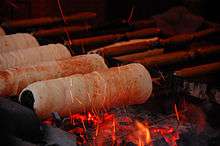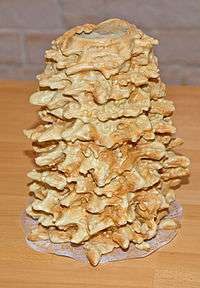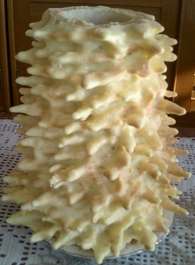Spit cake





Spit cake is a generic term that denotes a variety of European cakes all made in a similar way: layers of dough or batter are deposited, one at a time, onto a tapered cylindrical rotating spit; the dough is baked by an open fire or a special oven, rotisserie-style. Generally, spit cakes are associated with celebrations such as weddings and Christmas. The spit can be dipped in a thin dough, or the dough can be poured or rolled on the spit. This cake group may have originated from Ancient Greek times, around 400 BC, when similar large cakes were prepared on spits for Dionysiac feasts.[1][2]
Preparation techniques
The cooking process is similar for all the spit cakes: they all consist of a dough applied on a spit which is slowly rotated over an open fire or other heat source. One way of doing this is when the spit is dipped several times in a bowl with liquid dough or the thin dough is poured on spit. Depending on the dough's consistency and the spit's speed, it will form a layer on the spit, and when very runny, it will drop, thus producing small spikes, giving the cake a porcupine-like appearance. The resulting cake consists of many layers of cooked dough, and when cut is shown to consist of rings – hence another name, "tree cake".[3]
Alternatively, the dough is wrapped around the spit as spiral threads. In some varieties of the cake, while they maintain the shape of the spit cake, the rings are actually baked separately and attached to each other with icing. Some spit cakes have a smooth surface. Others, like spettekaka and šakotis, have an irregular shape.[4]
Varieties
Variations on the basic process are found in many cultures; what they have in common is that the laborious and time-consuming process produces a cake suitable for special occasions, such as weddings or Christmas feasts. Some varieties are made with a dough with flowing paste while others use a more solid dough. In Austria, spit cakes are known as Prügelkrapfen; in Germany there are two varieties called Baumkuchen and Baumstriezel; in Hungary kürtőskalács; in the Czech Republic and Slovakia trdelník; in Sweden spettekaka;[5] in Lithuania raguolis, šakotis, or baumkuchenas; and in Poland sękacz.[6]
Baumkuchen and Baumstriezel are German varieties of spit cake. Baumkuchen is prepared in the shape of a tree[7] and is served sliced in rings that resemble tree rings, and thus gave the cake its German name, Baumkuchen, which translates as "tree cake". Baumstriezel is made of a batter made with yeast, and has a caramel crust while the Baumkuchen is not baked with yeast but with baking powder, and has no crust of caramelized sugar. Baumkuchen has as its ingredients eggs, marzipan, sugar, butter and flour. Baumkuchen is served plain or with white sugar icing or covered with chocolate. This type of cake is known in Austria as Prügelkrapfen and in Luxembourg called Baamkuch, traditionally served on special occasions, such as weddings. The Austrian Prügelkrapfen or Prügeltorte is a variety of spit cake with a liquid base dough poured on the spit.[8][3][9]
Kürtőskalács is made of a dough made of wheat flour, egg, yeast, often extra egg yolks, milk, and butter, iced with sugar. The sugar will be caramelised, creating a hard, crisp brown layer on the cake's surface.[10][11]
Its Slovak version is called trdelník or Skalický trdelník , and it was registered in December 2007 as PGI (protected geographical indication) in the European Union.[12] The registration application with the detailed description of the product was published in April 2007 in the Official Journal of the European Union.[13] It is made from rolled dough that is wrapped around a stick, then grilled and topped with sugar and walnut mix.[14]
Šakotis or raguolis is the Lithuanian traditional spit cake, It is a cake made with a loose dough of butter, eggs, flour, sugar, and cream, poured on the spit, forming "stalactites" when dropping from the spit. In Lithuanian means "peaked" or "branchy" or "branched tree" due to its conical shape resembling a pine tree, and with the drips looking like the tree branches. It is baked in a time- and labor-intensive process, by pouring layers of dough onto a rotating spit in a special open oven or over an open fire.[15]
Spettekaka, the Swedish variety, is different in that the dough is made of potato flour. The ingredients are potato starch flour, sugar and eggs. The rest of the process is similar, the thin dough forming layers when it is slowly poured onto the skewer. The Spettekaka is a brittle and dry variety of this dessert, somewhat similar in consistency to meringue; it is light, airy and crisp. Spettekaka has a texture that readily breaks into little pieces under pressure, and they range in size anywhere from a few inches to several feet in height and over a foot in diameter. Small cakes are broken into pieces, while very large cakes are served by sawing them into pieces.
- Spit cake varieties
- Baumstriezel



- Trdelník slices

See also
References
- ↑ "The Kürtőskalács - Similar cakes.". kurtos.eu.
- ↑ "The Kürtőskalács - History".
- 1 2 Sheraton, Mimi (23 November 2009). "Spit Cake". The New Yorker. Retrieved 9 February 2015.
- ↑ "The Kürtőskalács - Similar cakes.". kurtos.eu.
- ↑ Monger, G. (2013). Marriage Customs of the World: An Encyclopedia of Dating Customs and Wedding Traditions, Expanded Second Edition [2 Volumes]. Marriage Customs of the World: An Encyclopedia of Dating Customs and Wedding Traditions. ABC-CLIO. p. 116. ISBN 978-1-59884-664-5. Retrieved February 10, 2015.
- ↑ "polish_food_desserts -Sękacz". www.tastingpoland.com.
- ↑ Snodgrass, M.E. (2004). Encyclopedia of Kitchen History. Taylor & Francis. p. 940. ISBN 978-1-135-45572-9. Retrieved February 10, 2015.
- ↑ "baumkuchen-multi-layered-tree-cake". yumarama.com. Retrieved 2015. Check date values in:
|access-date=(help) - ↑ Stanley Cauvain and Linda Young (2001). Baking problems solved. Woodhead Pub Ltd, p. 261. ISBN 0849312213.
- ↑ "Kürtőskalács". www.kurtos.eu. Retrieved 2015. Check date values in:
|access-date=(help) - ↑ "how to prepare Kürtőskalács". kurtos.eu.
- ↑ Commission Regulation (EC) No 1485/2007 of 14 December 2007 registering certain names in the Register of protected designations of origin and protected geographical indications (Carne de Bísaro Transmontano or Carne de Porco Transmontano (PDO), Szegedi szalámi or Szegedi téliszalámi (PDO), Pecorino di Filiano (PDO), Cereza del Jerte (PDO), Garbanzo de Fuentesaúco (PGI), Lenteja Pardina de Tierra de Campos (PGI), Λουκούμι Γεροσκήπου (Loukoumi Geroskipou) (PGI), Skalický trdelník (PGI))
- ↑ Publication of an application pursuant to Article 6(2) of Council Regulation (EC) No 510/2006 on the protection of geographical indications and designations of origin for agricultural products and foodstuffs – SKALICKÝ TRDELNÍK
- ↑ "Trdelnik". archiv.skalica.sk. Retrieved 2015. Check date values in:
|access-date=(help) - ↑ Lankauskas, Gediminas (2015). The Land of Weddings and Rain: Nation and Modernity in Post-Socialist Lithuania. U of Toronto P. pp. 208–11. ISBN 9781442612563.
Further reading
- Dubois, U.; Gastronomy, K.G.B.C. (1870). Artistic cookery: a practical system suited for the use of the nobility and gentry and for public entertainments. Longmans, Green. pp. 219–220. Retrieved February 10, 2015.
External links
|
| |
|
| |
|
|
-
 Media related to Spit cake at Wikimedia Commons
Media related to Spit cake at Wikimedia Commons
